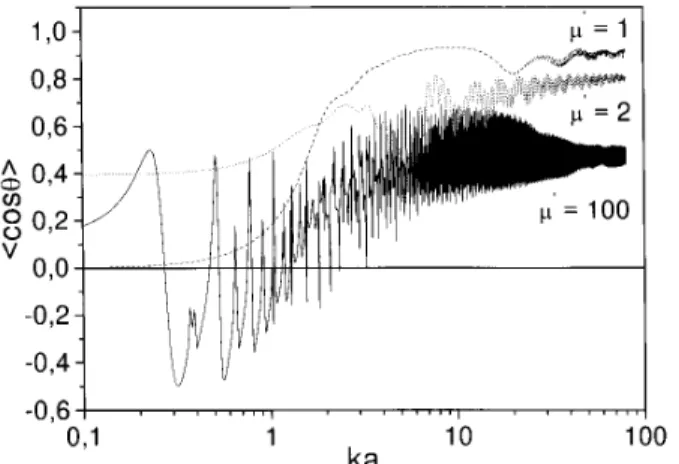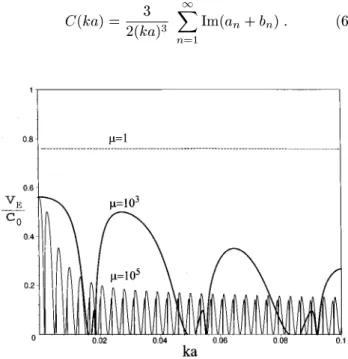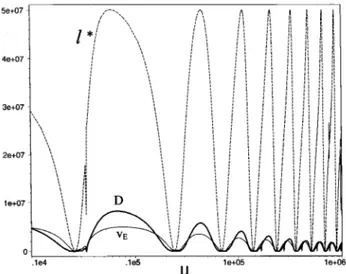Multiple Sattering of Eletromagneti Waves in
Disordered Magneti Media: Loalization Parameter,
Energy Transport Veloity and Diusion Constant
F.A.Pinheiro 1
, A.S.Martinez 2
; and L.C.Sampaio 1
1
CentroBrasileirode PesquisasFsias/CNPq,
RuaDr.XavierSigaud,150,CEP22290-180, RiodeJaneiro,RJ,Brazil
2
FauldadedeFilosoa,Ci^eniase Letrasde Ribeir~aoPreto,Universidadede S~aoPaulo,
Av.Bandeirantes 3900,CEP14040-901,Ribeir~aoPreto,SP,Brazil
Reeivedon16August,2000
Wereviewsomeof ourreent resultsonerningthesingleandmultipleeletromagnetisattering
bymagnetispherialpartiles. Forasingleeletromagnetisatteringweshowthatthemagneti
ontributionalters, whenomparedto nonmagnetisattering, thebehavior oftheross setions
andmeanosineofthesatteringangle(hosi). Forferromagnetipartiles,resonanesmayour
eveninthesmall-partilelimitwhenthepartileradiusismuhsmallerthanthewavelength.The
resonanesinreasetheross-setionswhilehosiisdiminished,andevenmaybeomenegative.
Several quantities suh the Ioe-Regel parameterfor loalization are alulated for the multiple
satteringregime. Weshowthatmagnetisatteringfavorstheobservationofloalizationof
ele-tromagneti wavesin threedimensions. Further,this is also veried for dynamial experiments,
whereweshowthatthediusiononstantanbeverysmall. Sinethemagnetipermeabilityofthe
satterersanvarysigniativelyaroundtheCurie-Weissritialtemperature,experimentsshould
bedone onthemirowaveregionandthe satterersshouldbesoft ferrites. Some aspetsof suh
experimentarepresented.
I Introdution
Theinterestinstudyingthepropagationof
eletromag-neti (EM) wavesin random media hasexperiened a
onsiderableinreaseoverthelast years. Afterthe
ob-servation of the oherent baksattering eet,[1℄ the
optial ounterpart of eletroni weak loalization, it
has beensoon realized that many eletroni eets in
ondensedmatterphysishavetheiranaloginEMwave
systems. Amongthese, arethephotoniHalleet,[2℄
theanisotropilightdiusion[3℄andtheloalizationof
light.[4℄Althoughthesephenomenaharaterizealose
analogy between EM waves and eletrons, dynamial
situationsonerningEMandeletronpropagation
re-vealfundamentaldierenesbetweenthem. [5℄Infat,
van Albada et al.[6, 7℄ have shown that, the energy
transportveloity v
E
, whih haraterizesthe
dynam-is of lightdiusion through the disordered media, is
not equalto thephase veloity v
p
as in theeletroni
ase. This is beausea orretion fator in v
E
(asso-iatedwiththestoredEMenergyinsideeahsatterer
due to Mie resonanes) should be taken into aount
in the optial ase, in ontrast to eletroni systems
sinefor eletron-impuritysatteringthisorretionis
However, in all multiple sattering phenomena
re-ported so far, inluding the destrution of the
o-herent baksatteringeet by magneto-optialative
materials,[8,9℄itisassumedthatthesatterersare
non-magneti. The presentpaperis thus devotedto
inves-tigate some aspets of single and multiple sattering
and diusion of EM waves through magneti random
media.[10,11,12℄
This paper is organized as follows. In Se. II we
treat both analytially and numerially the EM
sat-tering by a single magneti satterer, assumed to be
asphere. It is importantto point that several of the
mainpropertiesofmultiplesattering inmagneti
me-diaareessentiallydueto unusualfeatures whih
har-aterizesmagnetisinglesattering,suhaspreferential
baksatteringandresonaneeetseveninthe
small-partilelimit. InSe.III these resultsonerning
sin-glesatteringwillbeinsertedinthemultiplesattering
ontext,where wewill investigate theonsequenesof
theintrodutionofmagnetisatterersinthe
loaliza-tion parameter and oherent baksattering eet, in
theenergytransportveloityandin thediusion
on-stant. We haveshown that the presene of magneti
stant. Se. IV is devoted to the disussion of some
experimental aspets and possible appliations of our
results. Exploring the fat that the magneti
perme-abilityof magneti satterersis stronglydependentof
anexternalmagnetieldH
ext
andtypiallyfollowsthe
Curie-Weisslaw,wesuggestthatboththeloalization
parameterand thediusion onstantanbetuned by
varying either H
ext
or thetemperature. Finally, some
ommentsandonlusionsare addressedinSe.V.
II Single Sattering
In order to investigate the inuene of magneti
sat-terersontheloalizationparameterk`
(wherekisthe
wavenumberand `
is the transport meanfree path),
it is essential to onsider the single sattering of EM
waves by magneti partiles. In single Mie
satter-ing problem, aplane wave with wavelength is
sat-tered by a homogeneous magneti sphere of radius a,
omplexmagnetipermeability
s
andomplexeletri
permittivity
s
, leading to a omplexrefration index
n s =( s s ) 1=2
. Themediumhasarealeletri
permit-tivity
m
(itdoesnotabsorbnoremitlight)andvauum
magnetipermeability
0
, whihleadsto areal
refra-tive index n
m = ( m m ) 1=2
. The relative refrative
index ism=n
s =n
m =()
1=2
, where= 0 +{ 00 and = 0 +{ 00
are theomplexrelativeeletri
permit-tivity andtheomplexrelativemagneti permeability,
respetively. Both the satterersand the medium are
onsideredtobenonmagneto-optialative.
Although in standard texts on EM sattering [13,
14, 15℄therelativemagneti permeabilityis usually
assumedtobeunitary,thisisnolonger validfor
mag-neti partiles. In ferromagneti materials an
as-sume arather large spetrum ofvalues. For instane,
foranikelbulkatroomtemperature,isoftheorder
of10 6
forinidentradiationinthemirowaverange.[16℄
The quantities of interest in single sattering are
thetotal ross-setion andanisotropyfatorhosi,
whih an be expressed in terms of the Mie
oeÆ-ientsa
n andb
n
. [13,14,15℄Inthesmall-partilelimit
(ka1), wehave,in thelowestorderin ka,
a 1 = {(ka) 3 3 ka 0 1
(mka) 2m ~
1 (mka)
ka 0
1
(mka)+m ~
1 (mka) (1) b 1 = {(ka) 3 3 ~ mka 0 1 (mka) 2 1 (mka) ~ mka 0 1 (mka)+ 1 (mka) ; (2)
where m~ =m==(=) 1=2 and n (z)and 0 n (z)are
the Riatti-Bessel funtion and its derivative with
re-spettotheargument,respetively. It isimportantto
stress thefat that small-partile limitdoesnotmean
pointlikesatterers.
ToobtaintheRayleighlimit,onehasalsotoensure
that thesize ofthe sattererissmall ompared tothe
toa
1
=(1 )=(2+)andb
1
=(1 )=(2+),where
= 2{(ka) 3
=3.[17℄Notiethat allthedependene on
isintheb
1
term,whih vanishesin thenonmagneti
ase. Inthisase,theleadingtermintheb
1
expansion
isoftheorderof(ka) 5
. Theanisotropyfatorinterms
oflowestorderinkaishosi=<(a
1 b 1 )=(ja 1 j 2 +jb 1 j 2 ).
Notiethatinmagnetisatteringhosidoesnot
van-ish, inontrasttothenonmagnetiase.
It is important to point out that, when jj 1,
whihistheaseofferromagnetimaterials,the
small-partile limit must be treated in a dierent form. In
this ase, thelimitjmjka1 mustbeonsidered
us-ing
n
(z) os[z (n+1)=2℄ in Eqs. (1), leading
to: a 1 = {(ka) 3 3
p(m;ka)+2m~
p(m;ka) m~
(3) b 1 = {(ka) 3 3 ~
mp(m;ka)+2
~
mp(m;ka) 1
; (4)
where p(m;ka) = katan(mka). Dierently from the
Rayleigh limit, the a
1
term also has a magneti
on-tribution forlargevaluesofjj. Theperiodifuntion
tan(mka), whih depends on , is responsiblefor
res-onanes in hosi. Furthermore,these osillationsare
due to the real part of m, sine tan({x) = {tanh(x)
whihisnonperiodi.
Toanalyzeinmoredetailtheproblemofsingle
mag-neti sattering, we numeriallyalulate the valueof
hosiasafuntionofthesizeparameterkafor
diele-tri 00
= 0satterers for three dierent valuesof the
realpartoftherelativemagnetipermeability 0
,asis
exhibited in Fig.1 (for details, see Ref. [10℄). In the
small-partilelimit(ka1),thesatteringisisotropi
(hosi=0) fornonmagneti satterers(=1). The
appearane of usual Mie resonanes in hosi is
ob-served aska inreases. This situation hanges
drasti-ally when magneti satterersareonsidered. Notie
that EMsatteringbymagneti partilesis
harater-ized by the nonvanishing value of hosi even in the
small-partile limit, as it an be seen by 0
= 2 and
0
=100urves. Furthermore,weobservethepresene
ofresonanephenomenaforlargevaluesofin hosi
even in thesmall-partilelimit, whih isabsentin the
nonmagneti ase. This isin agreementwithour
ana-lytialresult[seeEqs. (2)andommentsthatfollow℄.
To further investigate EM sattering by magneti
partiles inthe small-partilelimit, inFig.2hosiis
exhibited as funtion of boththe real ( 0
) and
imagi-nary ( 00
) part of for ka = 0:63. hosi has an
os-illatorydependene on 0
, onrming thepreseneof
resonanephenomena. As 0
inreases,therealpartof
malsoinreases. Alargevalueofmleadstothe
build-ingupofstandingwavesinsidethesatterer,whihare
Figure 1. Thesattering anisotropyfator hosi,plotted
as a funtionof the size parameterka for three valuesof
the real part of the relative magnetipermeability:
non-magnetiase 0
=1(dashedurve), 0
=2(dottedurve)
and 0
=100(solidurve). Theotherparametersusedare:
0
=1:4161, 00
=0and 00
=0. [reprinted fromPinheiro,
Martinez andSampaio,Phys. Rev. Lett. 84, 1435(2000),
withpermissionfromtheAmerianPhysialSoiety℄.
Figure 2. hosi plottedas afuntion ofboth thereal 0
(solidurve)andtheimaginary 00
(dashedurve)partsof
in the small-partile limit ka = 0:63 and in the
large-partile limit ka= 63(inset). Therelative dieletri
on-stantis= 0
=1:4161. [reprintedfromPinheiro,Martinez
and Sampaio,Phys. Rev. Lett. 84, 1435(2000), with
per-missionfromtheAmerianPhysialSoiety℄.
values of , meaning a predominant bakward
sat-tering. This preferential baksattering in the
small-partile limit,whih isquiteunusual inEMsattering
bynonmagnetipartiles,isduetothesigniant
on-tribution given by magneti dipole radiation in
mag-netisattering.[17℄Ontheotherhand,notie the
ab-seneofresonaneswhenhasapureimaginaryvalue:
hosiisaveryslowlyvaryingfuntion of 00
. We
nu-meriallyobtainthelimitingvaluehosi 0:3when
00
! 1. This means that a high level of magneti
dissipation of energyontributes onlywith aonstant
negativevaluetohosiin thesmall-partilelimit. In
the inset of Fig. 2 hosi is plotted as a funtion of
0
and 00
for a size parameter ka = 63, in the
so-resonanesfor the realmagneti permeability ase,as
expeted,but thesatteringis alwayspreferentiallyin
theforwarddiretion,i.e.,hosi>0.
III Multiple Sattering
An important quantity in multiple sattering is the
meanlengththat the wavevetorloosememoryof the
inidenediretion. Thislength isgiven bythe
trans-port mean free path `
= `=(1 hosi), where ` =
1=(
t
)isthemeanfreepath,isthenumberof
par-tilepervolumeand
t
isthetotalsatteringross
se-tion. Theloalization(Ioe-Regel)parameterisdened
ask`
andstrongloalizationisexpetwhenk`
1.
III.1 Loalization parameter
In the following, using the above results
onern-ing single magneti sattering, we numerially
alu-late1=(k`
),whih isproportionalto thewidth ofthe
baksattering one, in a magneti medium for both
the small and large partile limits. We only onsider
the salar aspet of light propagation. In Fig. 3 we
showthe dependene of1=(k`
) onboth 0
and 00
in
the small-partile limit for dieletri satterers.
No-tie the global derease of the loalization parameter
induedby the presene of magneti (6= 1)
satter-ers. Furthermore, while 00
gives an almost onstant
ontributiontotheonewidth, 0
ontributestoafast
osillation. It is alsoimportant to point outthe wide
spetrumofvaluesinvolvedinthisosillation: theone
width an vary over three orders of magnitude when
jjvariesfrom1to100. Thisinterestingpatternofthe
angularproleofthebaksatteringoneisessentially
duetothefatthatthesatteringanisotropyan
osil-latebetweenpositiveandnegativevaluesasvaries.
Figure3.Theinverseoftheloalizationparameter1=(k`
),
proportionaltothebaksatteringonewidth,plottedasa
funtionofboth 0
(solidurve)and 00
(dashedurve)in
thesmall-partilelimit ka=0:63 for= 0
=1:4161. The
wavelengthis =633 nm and the onentration of
sat-terers = 0:01. [reprinted from Pinheiro, Martinez and
permis-Theosillatory behaviorfor realvaluesof isalso
present in the large-partile limit (see Fig. 4). Here,
notonlyweobserveaglobaldereaseintheloalization
parameter,whenomparedwiththenonmagnetiase,
but alsothefat that k`
dereases asboth 0
and 00
inreasesuntilitahievesasaturationminimumvalue.
Figure4.Theinverseoftheloalizationparameter1=(k`
)
plottedasafuntionofboth 0
(solidurve)and 00
(dashed
urve)inthelarge-partilelimitka=63for= 0
=1:4161.
The wavelength is = 633 nm and the onentration of
satterers = 0:01. [reprinted from Pinheiro, Martinez
andSampaio,Phys. Rev. Lett. 84,1435 (2000),with
per-missionfromtheAmerianPhysialSoiety℄.
III.2 Energy transport veloity and
dif-fusion onstant
The unusual resonant behavior exhibited by EM
sattering by magneti partiles in the small-partile
limitdisussed in Setion II hasalso important
impli-ationsinthedynamisofthediusionproess. Infat,
thediusion onstant D=v
E `
=3of EMpropagation
is strongly aeted in the presene of magneti
sat-terers, notonlythroughthe transport meanfreepath
`
, as disussed in Setion 3.1, but also through the
\transportveloity"v
E
. Thefatthatsinglesattering
bymagnetipartilesexhibitsaharateristiresonant
behavior,eveninthesmall-partilelimit,willintrodue
anextra timedelay in EMpropagation,ausing a
de-rease ofv
E
ifompared tothe nonmagnetiase. To
solve a disrepany between stationary and dynami
experiments, van Albada et al.,[6, 7℄ have developed
a salar theory using the low-density approximation,
whihtakesintoaountarenormalizationmehanism
ofD forlassialwaves. Aording tothis theory,the
transport veloity v
E
for spherialdieletriMie
sat-terersisgivenby:[7℄
v
E
0 =
0
v
p "
1+ 3f
4x 2
1
X
n=1
(2n+1) d(
n +
n )
dx
fC
2 #
1
;
(5)
where
0
istheveloityofpropagationin thevauum,
f isthepakingfrationandv = =(1+fC) 1=2
isthe
phase veloity. The phase angles
n
(ka) and
n (ka)
are dened in terms of the Mie sattering oeÆients
a
n
(ka)andb
n
(ka).[13℄TheparameterC(ka)isdened
aordingto:
C(ka)= 3
2(ka) 3
1
X
n=1 Im(a
n +b
n
): (6)
Figure 5. The energy transport veloity vE (normalized
by
0
), plotted as a funtion of ka in the small-partile
limit for three values of the (real) magneti permeability:
= 1 (dashed urve), = 10 3
(bold solid urve) and
= 10 5
(solid urve). The paking fration is f = 0:36
and= 0
=7:29. [reprinted fromPinheiro,Martinezand
Sampaio, Phys. Rev. Lett. ?? ,withpermissionfromthe
AmerianPhysialSoiety℄.
FromEqs. (2) and(3), wehaveanalytially
alu-lated v
E
forferromagnetiMiesatterersinthe
small-partilelimit,where resonanephenomenaarepresent
in a singular and unusual way. In Fig. 5, v
E is
ex-hibited as a funtion of the size parameter ka in the
small-partile limitforthreedierentvaluesof fora
pakingfrationf =0:36,thesameusedinexperiments
with nonmagneti satterersTiO
2
.[6℄Foromparison,
the urve =1 (nonmagneti ase), alulatedusing
thewell-knownexpressionsfora
1 andb
1
intheRayleigh
limit,[13,14,15℄isalsoshown. Notiethattheabsene
ofresonanesinthenonmagnetiase(=1)produes
analmostonstantvalueofv
E
. Thissituationhanges
drastiallywhenmagnetisatterersaretakeninto
a-ount. Inthisase,v
E
exhibitssharpdropseveninthe
small-partile limit, in lear ontrast to the
nonmag-neti ase where these drops only our in the
inter-mediateregime (ka1)andin thelarge-partilelimit
(ka1).[7℄Inaddition,notiethatv
E
anevenvanish
forsomevaluesofka. AspointedoutbyvanAlbadaet
al.,[6,7℄thesesharpdrops inv
E
areessentiallydueto
resonanes in thesatterers ross-setion,whih ause
thebuildingupofstandingwavesinsidethesatterers,
The inuene of the presene of magneti
satter-ers on the diusion onstant D in the small-partile
(ka = 0:01)limit an be seen in Fig. 6, where D, v
E
and `
areexhibited asafuntion oftherelative
mag-neti permeability . Here one an notie a striking
onsequeneoftheintrodutionofmagnetisatterers
in thedynami properties ofEM propagationthrough
disordered media: the presene of osillations in the
diusion onstantD. Forsomevaluesof, in
partiu-lar,oneanobservethesituationofvanishingdiusion
(D =0) of eletromagneti propagation. Inaddition,
it isinteresting topoint outthedampingin the
diu-siononstantosillationsinduedbytheinreaseofthe
valuesof.
Figure6. Thetransportveloityv
E
(solidurve),transport
meanfreepath`
(dashedurve)anddiusiononstantD
(boldsolidurve),plottedasafuntionofthe(real)(for
di-eletri ferromagneti satterersinthe small-partile limit
(ka = 0:01). In orderto exhibit dimensionlessquantities
v
E , `
and D are multiplied by 1=
0
, 3f=4aand 3f=4a
0 ,
respetively. For omparison, vE is multiplied by the
fa-tor 107. The other parameters used are: 0
= 7:29 and
f=0:36. [reprintedfromPinheiro,MartinezandSampaio,
Phys. Rev. Lett. ?? ,withpermissionfromthe Amerian
PhysialSoiety℄.
IV Experimental Aspets
Letusnowbrieydisusspossiblesituationswhereour
results ould be experimentally veried. Most of the
soft ferromagnets and ferrimagnets display high
mag-netipermeabilitytensorwithbeingstrongly
depen-dentonanexternalappliedmagnetieldH
ext andon
the temperature T, i.e., = (H
ext
;T). These fats
makeallthementionedpropertiesonerningboth
sin-gle and multiple sattering of EM waves by magneti
partiles tunable mehanisms: they an be ontrolled
bythevariationofanexternalparameter,suhasH
ext
or T. For instane, soft ferrites present large values
MHzandwithoutloss,whihinturnanbeeasily
on-trolled by the appliation of an external d magneti
biaseld.[17℄ Forthemajority of ferrites,in high
fre-quenies, beomes very small, whih turns the
uti-lizationofthistunablesatteringmehanismfairly
dif-ult at optial frequenies. This kind of restrition
tothemagnetipermeabilityhavealsobeenemployed
previously in other ontexts involving the interation
between eletromagneti radiation and magneti
ma-terials, suh as reported by Sigalas et al., who have
reentlydisussedthepossibilityofdesigningphotoni
rystalswithsoftmagnetimaterials.[19℄
The magnetipermeability of the vast majority of
ferritestypiallyfollowstheCurie-Weisslawabovethe
ritialtemperature,i.e., /(T T
)
1
.[17℄Thus, a
preise tuning of an be performed in this
temper-ature range. As a result, the utilization of magneti
satterersfollowing theCurie-Weiss suseptibility law
oersthepossibilitytotunethevalueofboththe
loal-izationparameterk`
andthediusion onstantD by
varying thesample temperature. In thelarge-partile
limit,inpartiular,thisfatouldbeexploredin
alter-nativeexperimentalinvestigationsofAnderson
loaliza-tionofEMwavessine,asthetemperatureapproahes
the Curie-Weiss ritial temperature, one an set k`
toaminimumvalue(seeSe. III).
Finally, we suggest that the possibility of
ontrol-lingtheosillationsin thediusiononstant(Se.III)
oersthetheoretialbasisfortheimplementationofa
magneto-optialdevie,abletoontrolthetransmission
ofEMwavesthroughdisorderedmagnetimedia. Suh
adeviewouldoperateasanoptial swithontrolled
by either the temperature orby an external d
mag-netield (fordevie appliationsexploringthe
trans-port properties of EM waves through random media
see,forinstane,Ref. [18℄).
V Conlusions
Summarizing,wehavestudiedtheinueneofmagneti
satterersonsingleand multipleeletromagneti
sat-tering,andtheirimpliationsintheoherent
baksat-tering eet, loalization parameter, energy transport
veloity and diusion onstant. We have shown that,
inthesmall-partilelimit,notonlysinglesattering
ex-hibitsaforward-bakwardspatialasymmetry,but also
anunusualresonaneeet. Inmultiplesattering
on-text,these unusualaspetsonerningsinglemagneti
satteringleadtoseveralinterestingonsequenes,suh
as the global derease of the loalization parameter,
sharp drops in the energy transport veloity even in
the small-partile limit and osillations in the
diu-siononstant. Furthermore,exploringthefatthatthe
magnetipermeabilityofmagnetisatterersisstrongly
dependentonanexternalmagnetieldH
ext
typ-that both theloalizationparameterand thediusion
onstant an be tuned by varying either H
ext or the
temperature.
Aknowledgments
We thank I. S. Oliveira and L. G. Guimar~aes for
fruitful disussions. This work was supported by the
BrazilianageniesCAPESandCNPq.
Referenes
[1℄ Y.KugaandA.Ishimaru,J.Opt. So. Am.A8,831
(1984);M.P.vanAlbadaandA.Lagendijk,Phys. Rev.
Lett. 55, 2692 (1985); P. E. Wolfand G.Maret, ibid.
55,2696 (1985).
[2℄ G.L.J.A.RikkenandB.A.vanTiggelen,Nature381,
54(1996).
[3℄ B.A.vanTiggelen,R.MaynardandA.HeiderihPhys.
Rev. Lett.77,639(1996);H.StarkandT.C.Lubensky,
ibid.77,2229(1996).
[4℄ D.S.Wiersma,P.Bartolini,A.LagendijkandR.
Righ-ini,Nature390,671(1997).
[5℄ B.A.vanTiggelenandA.Lagendjik,Phys. Rep.270,
143(1996).
[6℄ M.P.vanAlbada,B.A.vanTiggelen,A.Lagendijkand
A.Tip,Phys. Rev. Lett.66,3132 (1991);
[7℄ B. A. van Tiggelen, A. Lagendijk, M. P. van Albada,
andA.Tip,Phys. Rev.B45,12233(1992).
[8℄ R.LenkeandG.Maret,Phys. Sripta49,605(1993).
[9℄ A.S.MartinezandR.Maynard,Phys. Rev. B50,3714
(1994).
[10℄ F. A. Pinheiro, A. S. Martinez and L. C. Sampaio,
Phys. Rev. Lett.84,1435(2000).
[11℄ F.A.Pinheiro,A.S.MartinezandL.C.Sampaio,
Ele-tromagnetiSattering bySmallMagneti Partiles(to
appearin: JournalofMagnetismandMagneti
Materi-als).
[12℄ F.A.Pinheiro,A.S.MartinezandL.C.Sampaio,
Van-ishingof EnergyTransportVeloityandDiusion
Con-stant ofEletromagnetiWavesinDisorderedMagneti
Media(toappearin: Phys. Rev. Lett.).
[13℄ H.C.vandeHulst,LightSattering bySmallPartiles
(Dover,NewYork,1980).
[14℄ M.Kerker,TheSattering ofLightandOther
Eletro-magnetiRadiation (AademiPress,NewYork,1969).
[15℄ C.F.BohrenandD.R.Human,Absorptionand
Sat-tering of Light by Small Partiles (John Wiley, New
York,1983).
[16℄ C.W. Chen,Magnetism andMetallurgy ofSoft
Mag-netiMaterials(Dover,NewYork,1986).
[17℄ M. Kerker,D. S.WangandC.L. Giles,J.Opt. So.
Am.73,765(1983).
[18℄ A.Z.GenakandN.Garia,J.Opt. So. Am.B10,
408(1993).
[19℄ M. M. Sigalas, C. M. Soukoulis, R. Biswas, and


